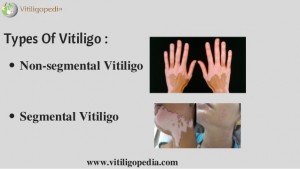Types of Vitiligo in two forms:

Non segmental Vitiligo– Non segmental vitiligo is the most commonly found category of vitiligo. In this type of vitiligo white patches can be noticed equally on the both sided of the body, with some kind of symmetry. These irregular white patches most commonly appear on skin that is exposed to the sun, prone to frictions and injury such as face, hands, lips, arms and the feet.
The non-segmental Vitiligo has several sub-categories:
-
Generalised Vitiligo: It is the most common type of vitiligo form and it involves loss of pigment in patches of skin all over the body. Generally, it appears in the symmetrical form.
-
Acrofacial Vitiligo: This type of vitiligo appears mostly on the fingers or toes, lips etc.
-
Mucosal Vitiligo: This type of vitiligo appears around the mucous membranes and lips and general areas.
-
Universal Vitiligo: Depigmented areas cover almost the entire body in universal vitiligo.
-
Focal vitiligo: In this type of vitiligo loss of pigment is limited to one patch.
Segmental Vitiligo: It is much less common. In this type of vitiligo, the depigmented skin occurs only on one side of the body. Segmental vitiligo is more noticeable in the young age, which rapidly progress for a year or two, and then stops. It is considered much constant and stable. It occurs more commonly on head and neck and trunk areas of the body.
Mixed Vitiligo: Mixed vitiligo is characterized by a combination of non-segmental vitiligo and segmental vitiligo. In this type of vitiligo, the sufferer will get segmental vitiligo for the first few years and then they will start getting patches of generalized vitiligo elsewhere. Apart from genetic susceptibility, metabolic disorders, vitamin deficiencies, and lifestyle could play a significant role in aggravating such situations.







Home » Types of Vitiligo